Coles Strategic Analysis
VerifiedAdded on 2022/12/23
|16
|4753
|29
AI Summary
This paper analyzes Coles' corporate strategy, including an environmental scan and SWOT analysis. It also discusses the strategic management process and the implementation of Coles' new strategy after demerging from Wesfarmers. Recommendations include continuous support to suppliers, evaluating expansion strategies, and staying committed to a customer-led strategy.
Contribute Materials
Your contribution can guide someone’s learning journey. Share your
documents today.

Coles strategic analysis
Name:
Course:
Name:
Course:
Secure Best Marks with AI Grader
Need help grading? Try our AI Grader for instant feedback on your assignments.
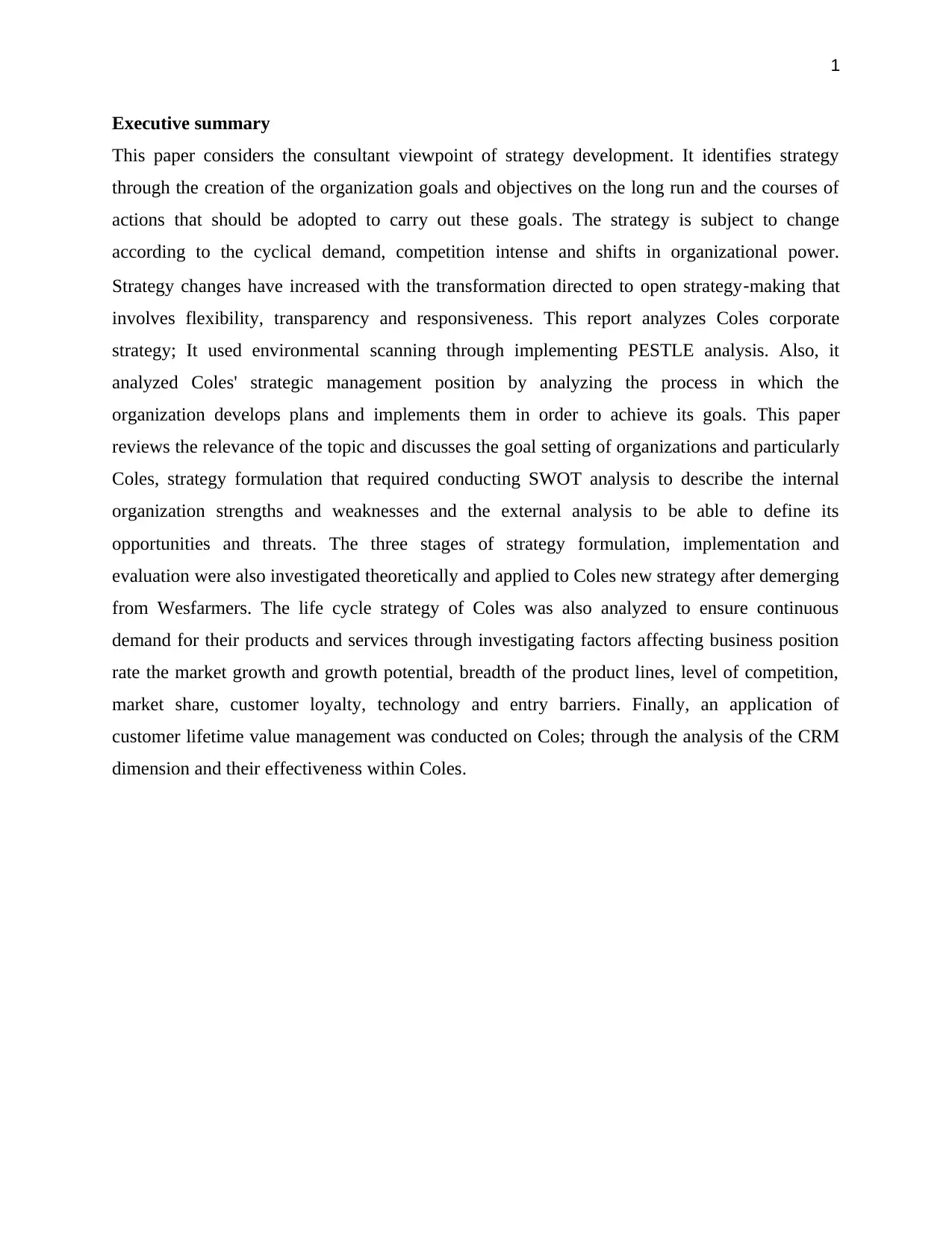
1
Executive summary
This paper considers the consultant viewpoint of strategy development. It identifies strategy
through the creation of the organization goals and objectives on the long run and the courses of
actions that should be adopted to carry out these goals. The strategy is subject to change
according to the cyclical demand, competition intense and shifts in organizational power.
Strategy changes have increased with the transformation directed to open strategy‐making that
involves flexibility, transparency and responsiveness. This report analyzes Coles corporate
strategy; It used environmental scanning through implementing PESTLE analysis. Also, it
analyzed Coles' strategic management position by analyzing the process in which the
organization develops plans and implements them in order to achieve its goals. This paper
reviews the relevance of the topic and discusses the goal setting of organizations and particularly
Coles, strategy formulation that required conducting SWOT analysis to describe the internal
organization strengths and weaknesses and the external analysis to be able to define its
opportunities and threats. The three stages of strategy formulation, implementation and
evaluation were also investigated theoretically and applied to Coles new strategy after demerging
from Wesfarmers. The life cycle strategy of Coles was also analyzed to ensure continuous
demand for their products and services through investigating factors affecting business position
rate the market growth and growth potential, breadth of the product lines, level of competition,
market share, customer loyalty, technology and entry barriers. Finally, an application of
customer lifetime value management was conducted on Coles; through the analysis of the CRM
dimension and their effectiveness within Coles.
Executive summary
This paper considers the consultant viewpoint of strategy development. It identifies strategy
through the creation of the organization goals and objectives on the long run and the courses of
actions that should be adopted to carry out these goals. The strategy is subject to change
according to the cyclical demand, competition intense and shifts in organizational power.
Strategy changes have increased with the transformation directed to open strategy‐making that
involves flexibility, transparency and responsiveness. This report analyzes Coles corporate
strategy; It used environmental scanning through implementing PESTLE analysis. Also, it
analyzed Coles' strategic management position by analyzing the process in which the
organization develops plans and implements them in order to achieve its goals. This paper
reviews the relevance of the topic and discusses the goal setting of organizations and particularly
Coles, strategy formulation that required conducting SWOT analysis to describe the internal
organization strengths and weaknesses and the external analysis to be able to define its
opportunities and threats. The three stages of strategy formulation, implementation and
evaluation were also investigated theoretically and applied to Coles new strategy after demerging
from Wesfarmers. The life cycle strategy of Coles was also analyzed to ensure continuous
demand for their products and services through investigating factors affecting business position
rate the market growth and growth potential, breadth of the product lines, level of competition,
market share, customer loyalty, technology and entry barriers. Finally, an application of
customer lifetime value management was conducted on Coles; through the analysis of the CRM
dimension and their effectiveness within Coles.
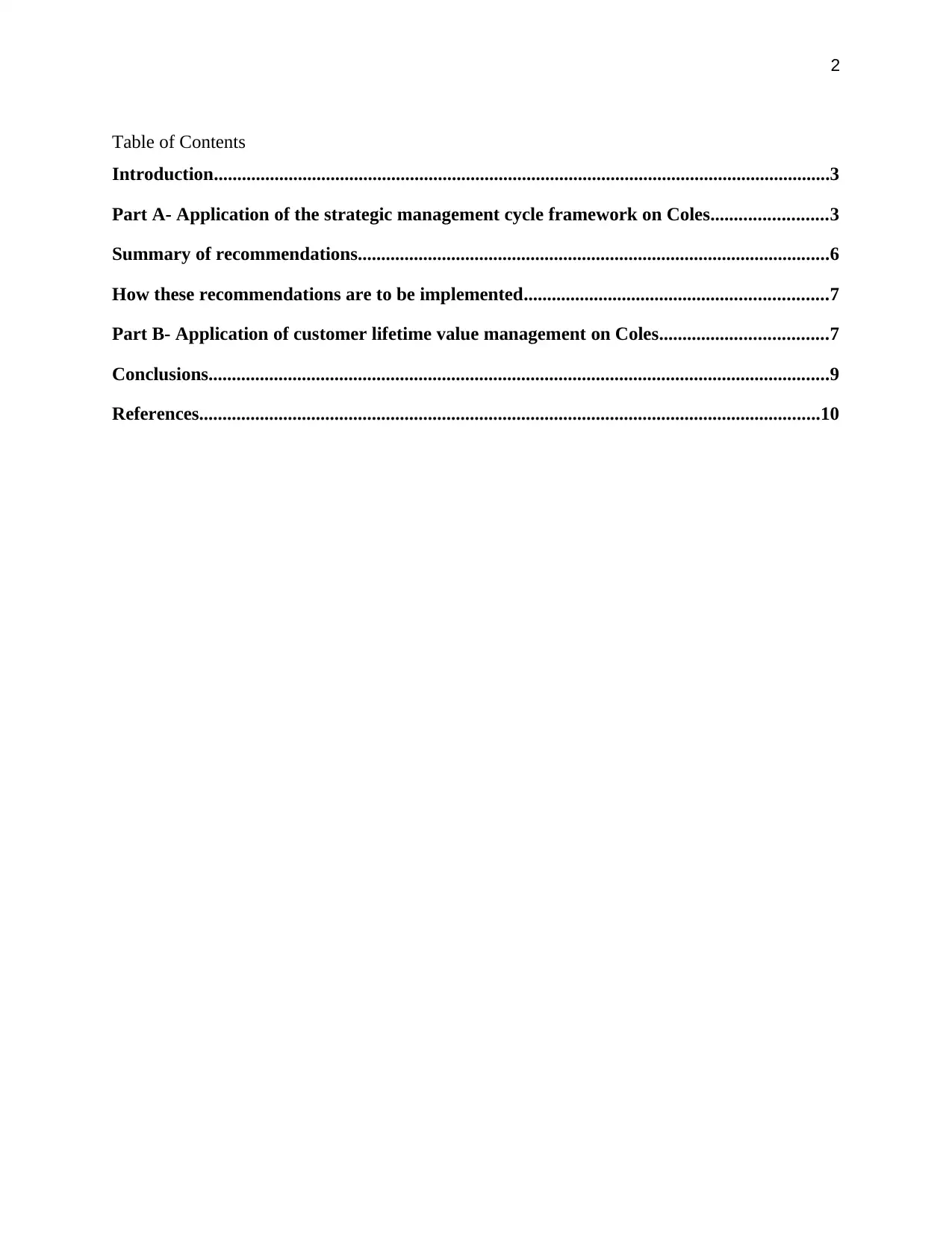
2
Table of Contents
Introduction....................................................................................................................................3
Part A- Application of the strategic management cycle framework on Coles.........................3
Summary of recommendations.....................................................................................................6
How these recommendations are to be implemented.................................................................7
Part B- Application of customer lifetime value management on Coles....................................7
Conclusions.....................................................................................................................................9
References.....................................................................................................................................10
Table of Contents
Introduction....................................................................................................................................3
Part A- Application of the strategic management cycle framework on Coles.........................3
Summary of recommendations.....................................................................................................6
How these recommendations are to be implemented.................................................................7
Part B- Application of customer lifetime value management on Coles....................................7
Conclusions.....................................................................................................................................9
References.....................................................................................................................................10
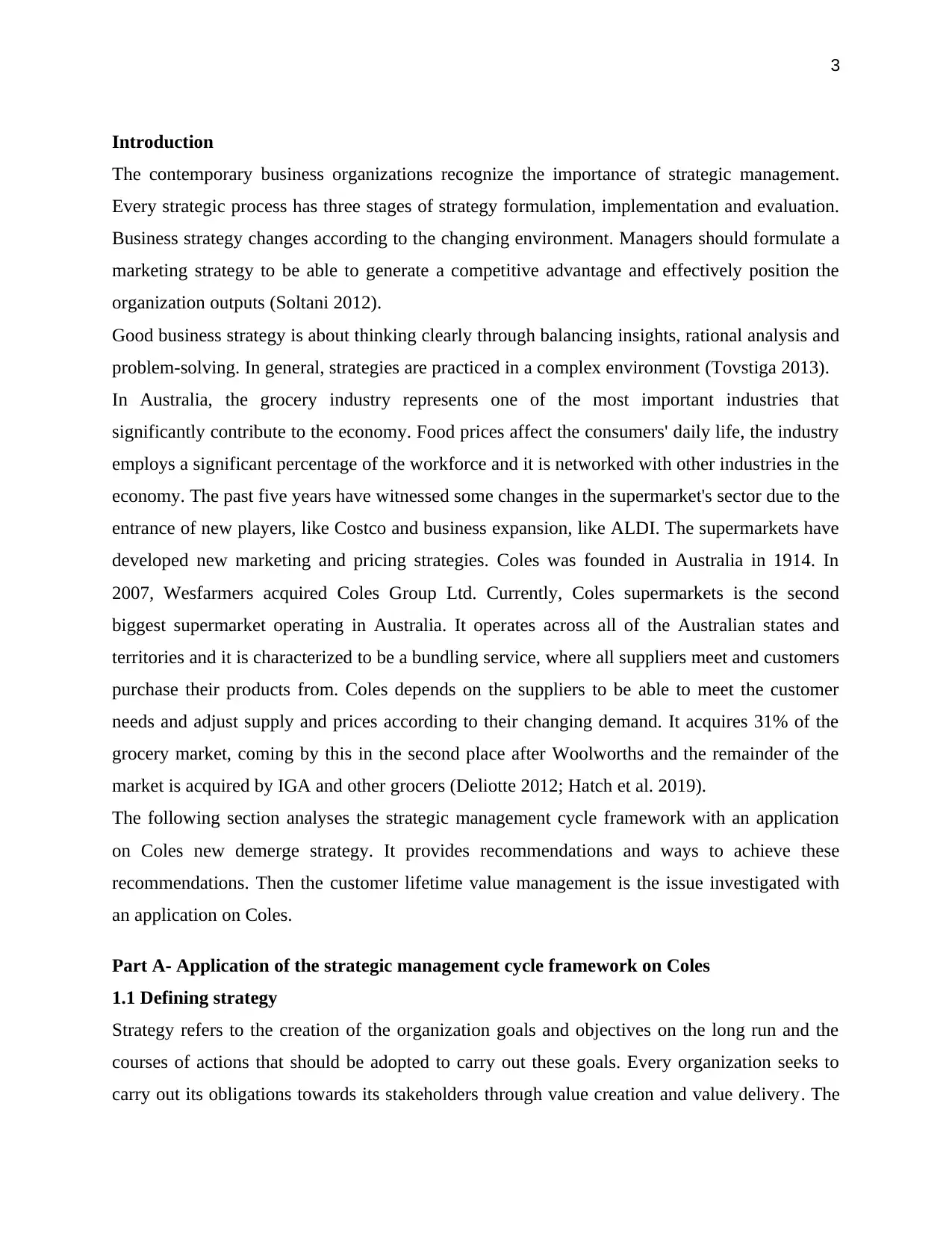
3
Introduction
The contemporary business organizations recognize the importance of strategic management.
Every strategic process has three stages of strategy formulation, implementation and evaluation.
Business strategy changes according to the changing environment. Managers should formulate a
marketing strategy to be able to generate a competitive advantage and effectively position the
organization outputs (Soltani 2012).
Good business strategy is about thinking clearly through balancing insights, rational analysis and
problem-solving. In general, strategies are practiced in a complex environment (Tovstiga 2013).
In Australia, the grocery industry represents one of the most important industries that
significantly contribute to the economy. Food prices affect the consumers' daily life, the industry
employs a significant percentage of the workforce and it is networked with other industries in the
economy. The past five years have witnessed some changes in the supermarket's sector due to the
entrance of new players, like Costco and business expansion, like ALDI. The supermarkets have
developed new marketing and pricing strategies. Coles was founded in Australia in 1914. In
2007, Wesfarmers acquired Coles Group Ltd. Currently, Coles supermarkets is the second
biggest supermarket operating in Australia. It operates across all of the Australian states and
territories and it is characterized to be a bundling service, where all suppliers meet and customers
purchase their products from. Coles depends on the suppliers to be able to meet the customer
needs and adjust supply and prices according to their changing demand. It acquires 31% of the
grocery market, coming by this in the second place after Woolworths and the remainder of the
market is acquired by IGA and other grocers (Deliotte 2012; Hatch et al. 2019).
The following section analyses the strategic management cycle framework with an application
on Coles new demerge strategy. It provides recommendations and ways to achieve these
recommendations. Then the customer lifetime value management is the issue investigated with
an application on Coles.
Part A- Application of the strategic management cycle framework on Coles
1.1 Defining strategy
Strategy refers to the creation of the organization goals and objectives on the long run and the
courses of actions that should be adopted to carry out these goals. Every organization seeks to
carry out its obligations towards its stakeholders through value creation and value delivery. The
Introduction
The contemporary business organizations recognize the importance of strategic management.
Every strategic process has three stages of strategy formulation, implementation and evaluation.
Business strategy changes according to the changing environment. Managers should formulate a
marketing strategy to be able to generate a competitive advantage and effectively position the
organization outputs (Soltani 2012).
Good business strategy is about thinking clearly through balancing insights, rational analysis and
problem-solving. In general, strategies are practiced in a complex environment (Tovstiga 2013).
In Australia, the grocery industry represents one of the most important industries that
significantly contribute to the economy. Food prices affect the consumers' daily life, the industry
employs a significant percentage of the workforce and it is networked with other industries in the
economy. The past five years have witnessed some changes in the supermarket's sector due to the
entrance of new players, like Costco and business expansion, like ALDI. The supermarkets have
developed new marketing and pricing strategies. Coles was founded in Australia in 1914. In
2007, Wesfarmers acquired Coles Group Ltd. Currently, Coles supermarkets is the second
biggest supermarket operating in Australia. It operates across all of the Australian states and
territories and it is characterized to be a bundling service, where all suppliers meet and customers
purchase their products from. Coles depends on the suppliers to be able to meet the customer
needs and adjust supply and prices according to their changing demand. It acquires 31% of the
grocery market, coming by this in the second place after Woolworths and the remainder of the
market is acquired by IGA and other grocers (Deliotte 2012; Hatch et al. 2019).
The following section analyses the strategic management cycle framework with an application
on Coles new demerge strategy. It provides recommendations and ways to achieve these
recommendations. Then the customer lifetime value management is the issue investigated with
an application on Coles.
Part A- Application of the strategic management cycle framework on Coles
1.1 Defining strategy
Strategy refers to the creation of the organization goals and objectives on the long run and the
courses of actions that should be adopted to carry out these goals. Every organization seeks to
carry out its obligations towards its stakeholders through value creation and value delivery. The
Secure Best Marks with AI Grader
Need help grading? Try our AI Grader for instant feedback on your assignments.

4
strategy is about assuring that the organization can achieve its goals within a specific time frame
by using its scarce resources and integrating its activities (Tovstiga 2013).
1.2 Corporate strategy
Corporate strategy deals with the organization as a whole, it is concerned with the market
definition. It starts with an environmental scan to identify organization opportunities and threats.
Coles environmental scanning requires implementing PESTLE analysis. It is conducted
according to Wesfarmers (2018), as follows:
Political factors: Coles enjoys political stability in Australia, the matter that allows the
company to benefit from stable growth opportunity.
Economic factors: The retail industry in Australia was not highly affected by the financial
crisis, it witnessed a more stable environment compared to other economic sectors.
Social factors: Customers seek not only to purchase value products, but they also seek to have
a shopping experience. Coles gains customer trust and satisfaction through timely response to
their needs.
Technological factors: Customers are highly adaptive with technology development and its
applications. Coles has to link the customer needs to the new technology accepted by them to
facilitate the shopping experience and payment service.
Legal factors: The recruitment and taxation policies are part of the legal framework in the
interest of Coles. Also, the food licensing requirement is important.
Environmental factors: They refer to friendly business practices and reducing the harm to the
environment. Coles implements environmental friendly activities and recycling materials.
1.4 Strategic management
Strategic management refers to the organizational process of developing plans and implementing
them in order to achieve its goals. It is a continuous process that evolves according to the
organization changing goals. An integrative approach assumes that strategic management
combines analysis, formulation and implementation of the strategy. Organizations analyses the
internal and external environments in order to formulate the strategy (Maleka 2014).
Coles latest financial results reveal the challenges that the company faces; costs are increasing
faster than sales, the traditional sales are higher than the online sales. Therefore, Coles CEO
highlighted 6 major strategies of transforming food offers, reviewing the method of pricing,
strategy is about assuring that the organization can achieve its goals within a specific time frame
by using its scarce resources and integrating its activities (Tovstiga 2013).
1.2 Corporate strategy
Corporate strategy deals with the organization as a whole, it is concerned with the market
definition. It starts with an environmental scan to identify organization opportunities and threats.
Coles environmental scanning requires implementing PESTLE analysis. It is conducted
according to Wesfarmers (2018), as follows:
Political factors: Coles enjoys political stability in Australia, the matter that allows the
company to benefit from stable growth opportunity.
Economic factors: The retail industry in Australia was not highly affected by the financial
crisis, it witnessed a more stable environment compared to other economic sectors.
Social factors: Customers seek not only to purchase value products, but they also seek to have
a shopping experience. Coles gains customer trust and satisfaction through timely response to
their needs.
Technological factors: Customers are highly adaptive with technology development and its
applications. Coles has to link the customer needs to the new technology accepted by them to
facilitate the shopping experience and payment service.
Legal factors: The recruitment and taxation policies are part of the legal framework in the
interest of Coles. Also, the food licensing requirement is important.
Environmental factors: They refer to friendly business practices and reducing the harm to the
environment. Coles implements environmental friendly activities and recycling materials.
1.4 Strategic management
Strategic management refers to the organizational process of developing plans and implementing
them in order to achieve its goals. It is a continuous process that evolves according to the
organization changing goals. An integrative approach assumes that strategic management
combines analysis, formulation and implementation of the strategy. Organizations analyses the
internal and external environments in order to formulate the strategy (Maleka 2014).
Coles latest financial results reveal the challenges that the company faces; costs are increasing
faster than sales, the traditional sales are higher than the online sales. Therefore, Coles CEO
highlighted 6 major strategies of transforming food offers, reviewing the method of pricing,
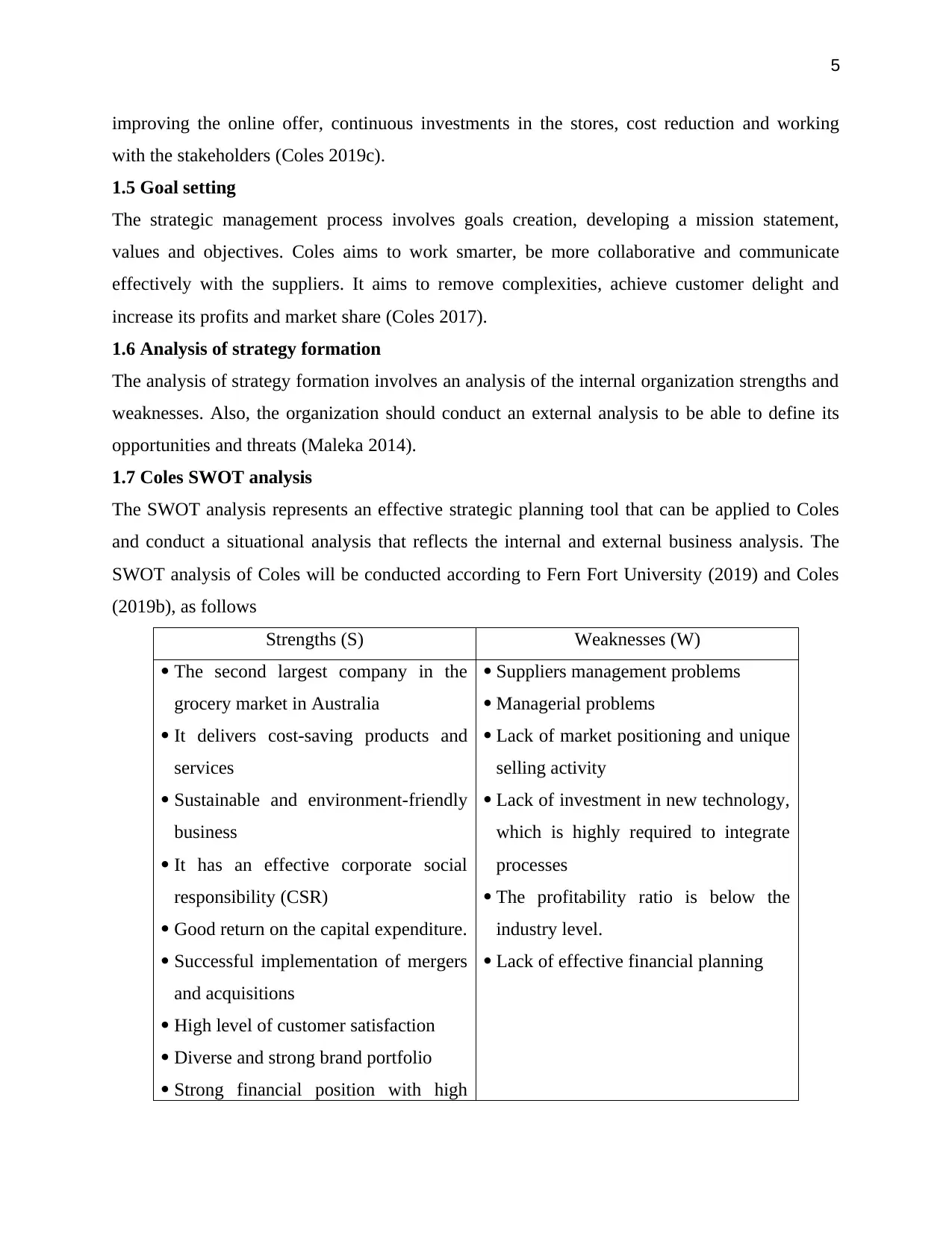
5
improving the online offer, continuous investments in the stores, cost reduction and working
with the stakeholders (Coles 2019c).
1.5 Goal setting
The strategic management process involves goals creation, developing a mission statement,
values and objectives. Coles aims to work smarter, be more collaborative and communicate
effectively with the suppliers. It aims to remove complexities, achieve customer delight and
increase its profits and market share (Coles 2017).
1.6 Analysis of strategy formation
The analysis of strategy formation involves an analysis of the internal organization strengths and
weaknesses. Also, the organization should conduct an external analysis to be able to define its
opportunities and threats (Maleka 2014).
1.7 Coles SWOT analysis
The SWOT analysis represents an effective strategic planning tool that can be applied to Coles
and conduct a situational analysis that reflects the internal and external business analysis. The
SWOT analysis of Coles will be conducted according to Fern Fort University (2019) and Coles
(2019b), as follows
Strengths (S) Weaknesses (W)
The second largest company in the
grocery market in Australia
It delivers cost-saving products and
services
Sustainable and environment-friendly
business
It has an effective corporate social
responsibility (CSR)
Good return on the capital expenditure.
Successful implementation of mergers
and acquisitions
High level of customer satisfaction
Diverse and strong brand portfolio
Strong financial position with high
Suppliers management problems
Managerial problems
Lack of market positioning and unique
selling activity
Lack of investment in new technology,
which is highly required to integrate
processes
The profitability ratio is below the
industry level.
Lack of effective financial planning
improving the online offer, continuous investments in the stores, cost reduction and working
with the stakeholders (Coles 2019c).
1.5 Goal setting
The strategic management process involves goals creation, developing a mission statement,
values and objectives. Coles aims to work smarter, be more collaborative and communicate
effectively with the suppliers. It aims to remove complexities, achieve customer delight and
increase its profits and market share (Coles 2017).
1.6 Analysis of strategy formation
The analysis of strategy formation involves an analysis of the internal organization strengths and
weaknesses. Also, the organization should conduct an external analysis to be able to define its
opportunities and threats (Maleka 2014).
1.7 Coles SWOT analysis
The SWOT analysis represents an effective strategic planning tool that can be applied to Coles
and conduct a situational analysis that reflects the internal and external business analysis. The
SWOT analysis of Coles will be conducted according to Fern Fort University (2019) and Coles
(2019b), as follows
Strengths (S) Weaknesses (W)
The second largest company in the
grocery market in Australia
It delivers cost-saving products and
services
Sustainable and environment-friendly
business
It has an effective corporate social
responsibility (CSR)
Good return on the capital expenditure.
Successful implementation of mergers
and acquisitions
High level of customer satisfaction
Diverse and strong brand portfolio
Strong financial position with high
Suppliers management problems
Managerial problems
Lack of market positioning and unique
selling activity
Lack of investment in new technology,
which is highly required to integrate
processes
The profitability ratio is below the
industry level.
Lack of effective financial planning
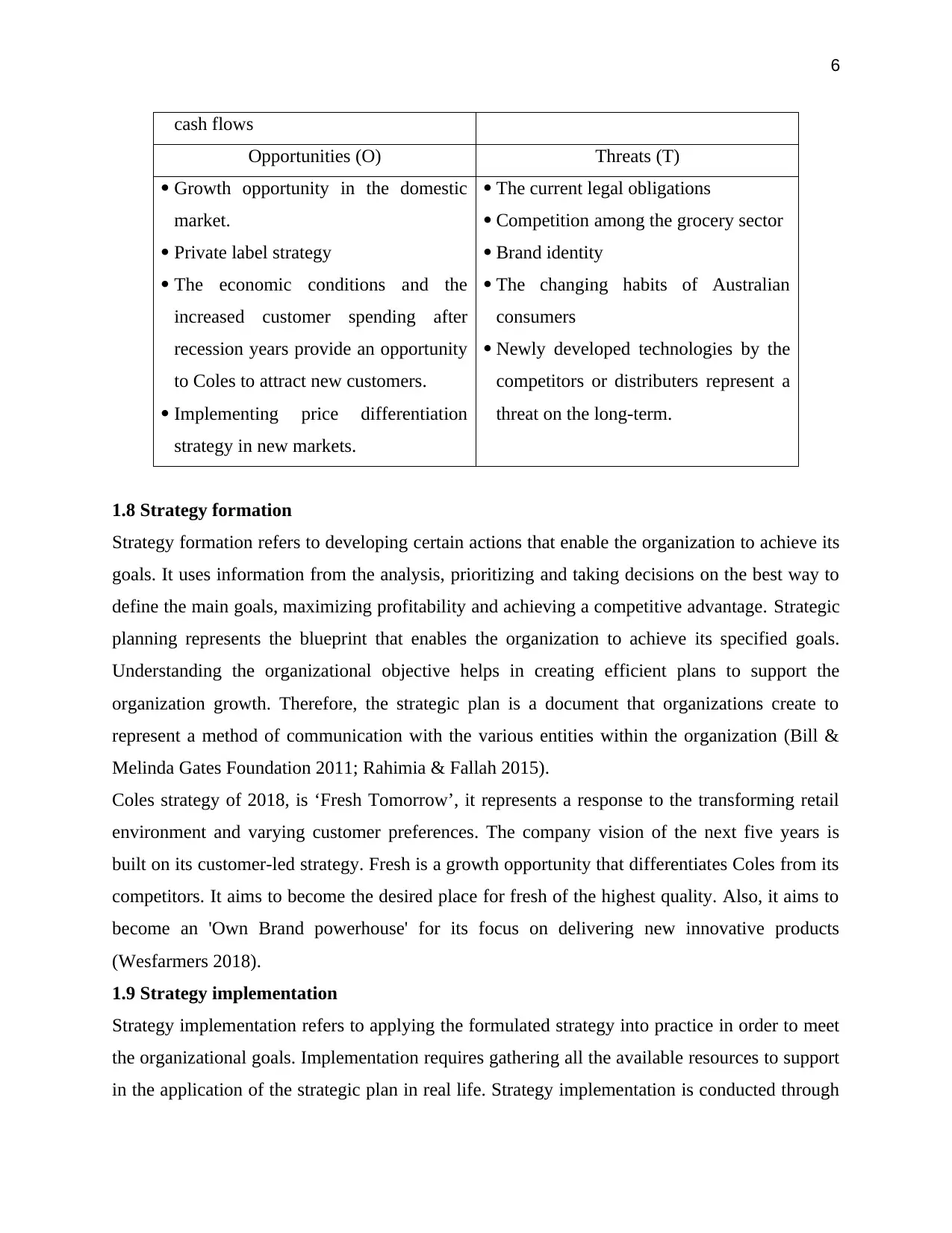
6
cash flows
Opportunities (O) Threats (T)
Growth opportunity in the domestic
market.
Private label strategy
The economic conditions and the
increased customer spending after
recession years provide an opportunity
to Coles to attract new customers.
Implementing price differentiation
strategy in new markets.
The current legal obligations
Competition among the grocery sector
Brand identity
The changing habits of Australian
consumers
Newly developed technologies by the
competitors or distributers represent a
threat on the long-term.
1.8 Strategy formation
Strategy formation refers to developing certain actions that enable the organization to achieve its
goals. It uses information from the analysis, prioritizing and taking decisions on the best way to
define the main goals, maximizing profitability and achieving a competitive advantage. Strategic
planning represents the blueprint that enables the organization to achieve its specified goals.
Understanding the organizational objective helps in creating efficient plans to support the
organization growth. Therefore, the strategic plan is a document that organizations create to
represent a method of communication with the various entities within the organization (Bill &
Melinda Gates Foundation 2011; Rahimia & Fallah 2015).
Coles strategy of 2018, is ‘Fresh Tomorrow’, it represents a response to the transforming retail
environment and varying customer preferences. The company vision of the next five years is
built on its customer-led strategy. Fresh is a growth opportunity that differentiates Coles from its
competitors. It aims to become the desired place for fresh of the highest quality. Also, it aims to
become an 'Own Brand powerhouse' for its focus on delivering new innovative products
(Wesfarmers 2018).
1.9 Strategy implementation
Strategy implementation refers to applying the formulated strategy into practice in order to meet
the organizational goals. Implementation requires gathering all the available resources to support
in the application of the strategic plan in real life. Strategy implementation is conducted through
cash flows
Opportunities (O) Threats (T)
Growth opportunity in the domestic
market.
Private label strategy
The economic conditions and the
increased customer spending after
recession years provide an opportunity
to Coles to attract new customers.
Implementing price differentiation
strategy in new markets.
The current legal obligations
Competition among the grocery sector
Brand identity
The changing habits of Australian
consumers
Newly developed technologies by the
competitors or distributers represent a
threat on the long-term.
1.8 Strategy formation
Strategy formation refers to developing certain actions that enable the organization to achieve its
goals. It uses information from the analysis, prioritizing and taking decisions on the best way to
define the main goals, maximizing profitability and achieving a competitive advantage. Strategic
planning represents the blueprint that enables the organization to achieve its specified goals.
Understanding the organizational objective helps in creating efficient plans to support the
organization growth. Therefore, the strategic plan is a document that organizations create to
represent a method of communication with the various entities within the organization (Bill &
Melinda Gates Foundation 2011; Rahimia & Fallah 2015).
Coles strategy of 2018, is ‘Fresh Tomorrow’, it represents a response to the transforming retail
environment and varying customer preferences. The company vision of the next five years is
built on its customer-led strategy. Fresh is a growth opportunity that differentiates Coles from its
competitors. It aims to become the desired place for fresh of the highest quality. Also, it aims to
become an 'Own Brand powerhouse' for its focus on delivering new innovative products
(Wesfarmers 2018).
1.9 Strategy implementation
Strategy implementation refers to applying the formulated strategy into practice in order to meet
the organizational goals. Implementation requires gathering all the available resources to support
in the application of the strategic plan in real life. Strategy implementation is conducted through
Paraphrase This Document
Need a fresh take? Get an instant paraphrase of this document with our AI Paraphraser
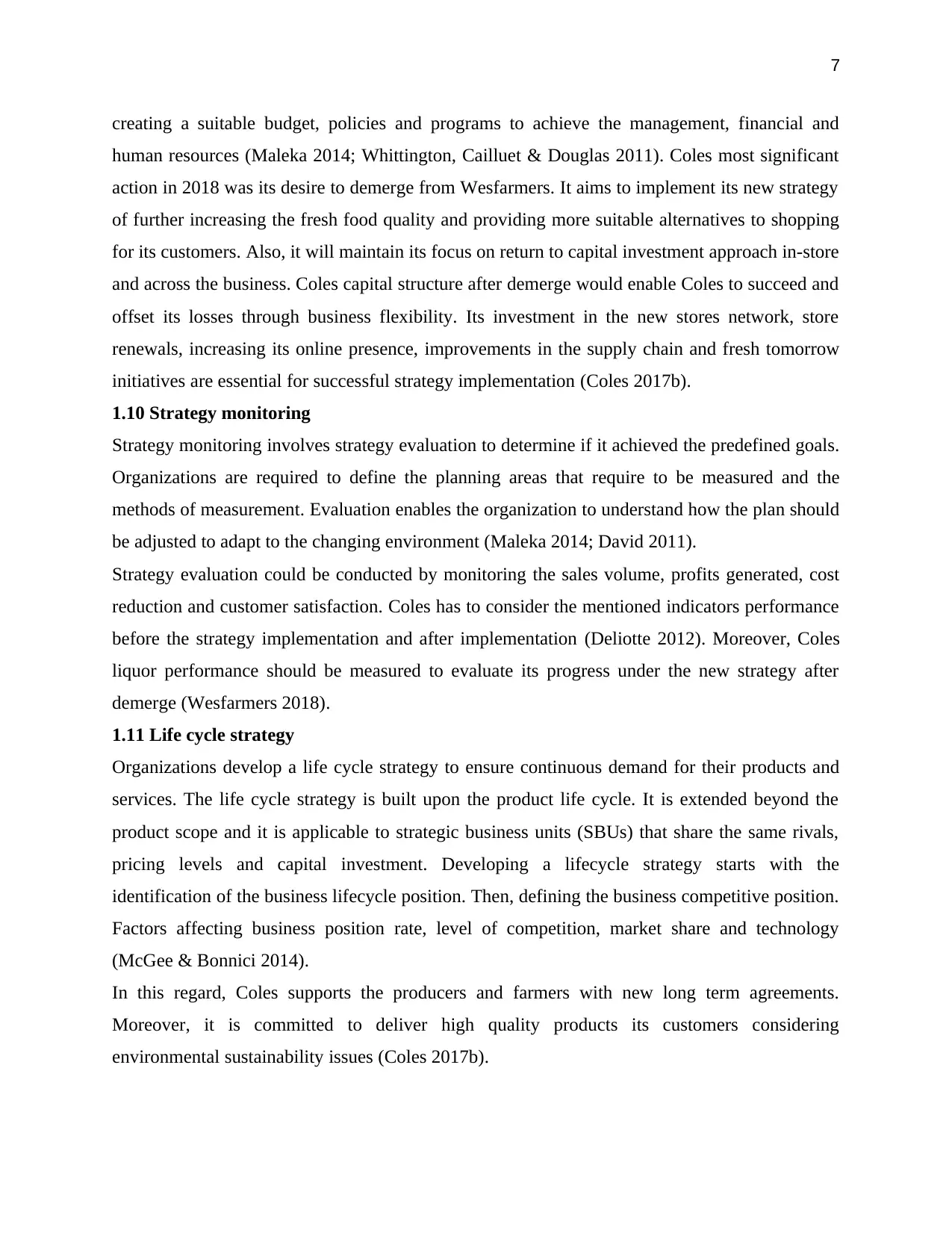
7
creating a suitable budget, policies and programs to achieve the management, financial and
human resources (Maleka 2014; Whittington, Cailluet & Douglas 2011). Coles most significant
action in 2018 was its desire to demerge from Wesfarmers. It aims to implement its new strategy
of further increasing the fresh food quality and providing more suitable alternatives to shopping
for its customers. Also, it will maintain its focus on return to capital investment approach in-store
and across the business. Coles capital structure after demerge would enable Coles to succeed and
offset its losses through business flexibility. Its investment in the new stores network, store
renewals, increasing its online presence, improvements in the supply chain and fresh tomorrow
initiatives are essential for successful strategy implementation (Coles 2017b).
1.10 Strategy monitoring
Strategy monitoring involves strategy evaluation to determine if it achieved the predefined goals.
Organizations are required to define the planning areas that require to be measured and the
methods of measurement. Evaluation enables the organization to understand how the plan should
be adjusted to adapt to the changing environment (Maleka 2014; David 2011).
Strategy evaluation could be conducted by monitoring the sales volume, profits generated, cost
reduction and customer satisfaction. Coles has to consider the mentioned indicators performance
before the strategy implementation and after implementation (Deliotte 2012). Moreover, Coles
liquor performance should be measured to evaluate its progress under the new strategy after
demerge (Wesfarmers 2018).
1.11 Life cycle strategy
Organizations develop a life cycle strategy to ensure continuous demand for their products and
services. The life cycle strategy is built upon the product life cycle. It is extended beyond the
product scope and it is applicable to strategic business units (SBUs) that share the same rivals,
pricing levels and capital investment. Developing a lifecycle strategy starts with the
identification of the business lifecycle position. Then, defining the business competitive position.
Factors affecting business position rate, level of competition, market share and technology
(McGee & Bonnici 2014).
In this regard, Coles supports the producers and farmers with new long term agreements.
Moreover, it is committed to deliver high quality products its customers considering
environmental sustainability issues (Coles 2017b).
creating a suitable budget, policies and programs to achieve the management, financial and
human resources (Maleka 2014; Whittington, Cailluet & Douglas 2011). Coles most significant
action in 2018 was its desire to demerge from Wesfarmers. It aims to implement its new strategy
of further increasing the fresh food quality and providing more suitable alternatives to shopping
for its customers. Also, it will maintain its focus on return to capital investment approach in-store
and across the business. Coles capital structure after demerge would enable Coles to succeed and
offset its losses through business flexibility. Its investment in the new stores network, store
renewals, increasing its online presence, improvements in the supply chain and fresh tomorrow
initiatives are essential for successful strategy implementation (Coles 2017b).
1.10 Strategy monitoring
Strategy monitoring involves strategy evaluation to determine if it achieved the predefined goals.
Organizations are required to define the planning areas that require to be measured and the
methods of measurement. Evaluation enables the organization to understand how the plan should
be adjusted to adapt to the changing environment (Maleka 2014; David 2011).
Strategy evaluation could be conducted by monitoring the sales volume, profits generated, cost
reduction and customer satisfaction. Coles has to consider the mentioned indicators performance
before the strategy implementation and after implementation (Deliotte 2012). Moreover, Coles
liquor performance should be measured to evaluate its progress under the new strategy after
demerge (Wesfarmers 2018).
1.11 Life cycle strategy
Organizations develop a life cycle strategy to ensure continuous demand for their products and
services. The life cycle strategy is built upon the product life cycle. It is extended beyond the
product scope and it is applicable to strategic business units (SBUs) that share the same rivals,
pricing levels and capital investment. Developing a lifecycle strategy starts with the
identification of the business lifecycle position. Then, defining the business competitive position.
Factors affecting business position rate, level of competition, market share and technology
(McGee & Bonnici 2014).
In this regard, Coles supports the producers and farmers with new long term agreements.
Moreover, it is committed to deliver high quality products its customers considering
environmental sustainability issues (Coles 2017b).
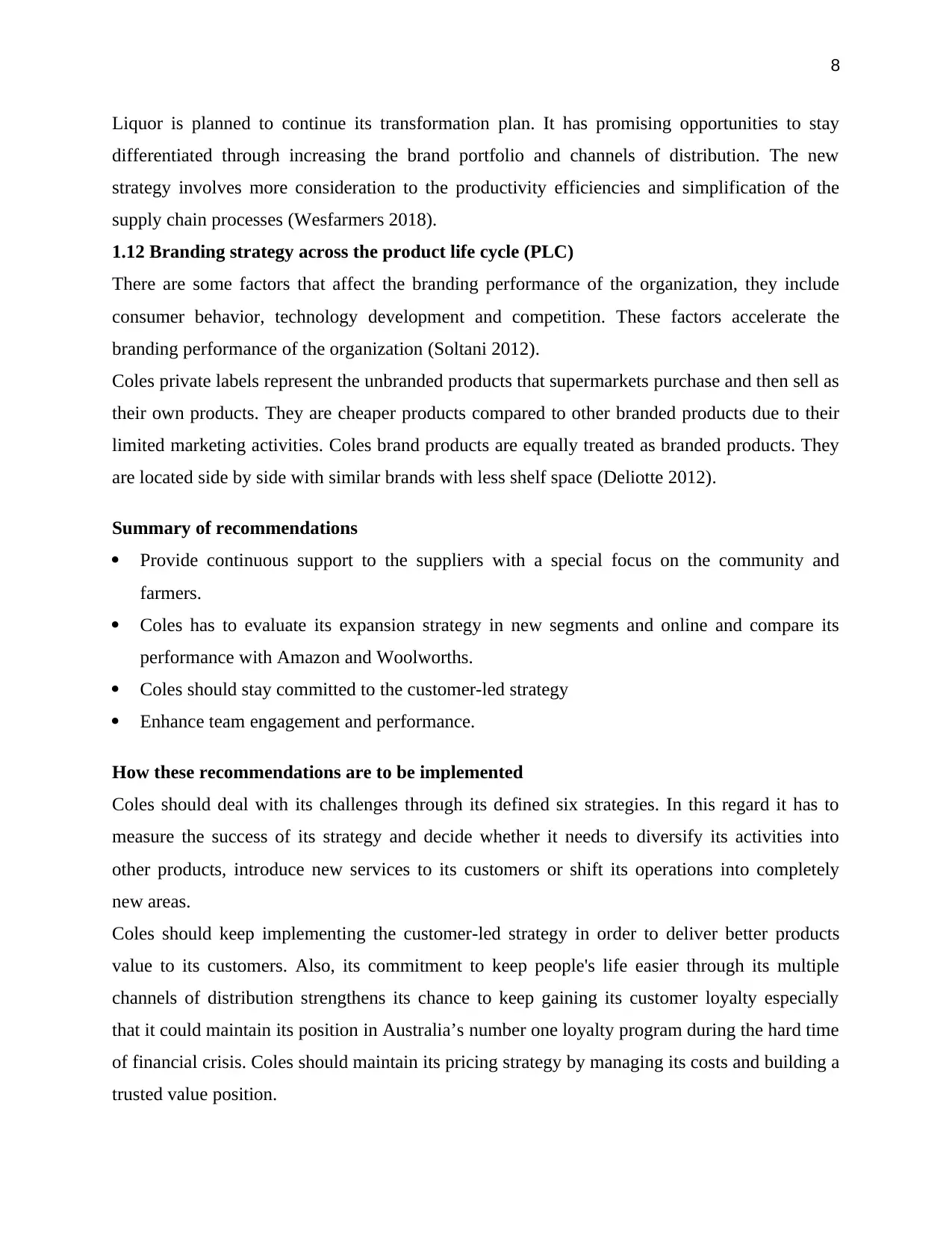
8
Liquor is planned to continue its transformation plan. It has promising opportunities to stay
differentiated through increasing the brand portfolio and channels of distribution. The new
strategy involves more consideration to the productivity efficiencies and simplification of the
supply chain processes (Wesfarmers 2018).
1.12 Branding strategy across the product life cycle (PLC)
There are some factors that affect the branding performance of the organization, they include
consumer behavior, technology development and competition. These factors accelerate the
branding performance of the organization (Soltani 2012).
Coles private labels represent the unbranded products that supermarkets purchase and then sell as
their own products. They are cheaper products compared to other branded products due to their
limited marketing activities. Coles brand products are equally treated as branded products. They
are located side by side with similar brands with less shelf space (Deliotte 2012).
Summary of recommendations
Provide continuous support to the suppliers with a special focus on the community and
farmers.
Coles has to evaluate its expansion strategy in new segments and online and compare its
performance with Amazon and Woolworths.
Coles should stay committed to the customer-led strategy
Enhance team engagement and performance.
How these recommendations are to be implemented
Coles should deal with its challenges through its defined six strategies. In this regard it has to
measure the success of its strategy and decide whether it needs to diversify its activities into
other products, introduce new services to its customers or shift its operations into completely
new areas.
Coles should keep implementing the customer-led strategy in order to deliver better products
value to its customers. Also, its commitment to keep people's life easier through its multiple
channels of distribution strengthens its chance to keep gaining its customer loyalty especially
that it could maintain its position in Australia’s number one loyalty program during the hard time
of financial crisis. Coles should maintain its pricing strategy by managing its costs and building a
trusted value position.
Liquor is planned to continue its transformation plan. It has promising opportunities to stay
differentiated through increasing the brand portfolio and channels of distribution. The new
strategy involves more consideration to the productivity efficiencies and simplification of the
supply chain processes (Wesfarmers 2018).
1.12 Branding strategy across the product life cycle (PLC)
There are some factors that affect the branding performance of the organization, they include
consumer behavior, technology development and competition. These factors accelerate the
branding performance of the organization (Soltani 2012).
Coles private labels represent the unbranded products that supermarkets purchase and then sell as
their own products. They are cheaper products compared to other branded products due to their
limited marketing activities. Coles brand products are equally treated as branded products. They
are located side by side with similar brands with less shelf space (Deliotte 2012).
Summary of recommendations
Provide continuous support to the suppliers with a special focus on the community and
farmers.
Coles has to evaluate its expansion strategy in new segments and online and compare its
performance with Amazon and Woolworths.
Coles should stay committed to the customer-led strategy
Enhance team engagement and performance.
How these recommendations are to be implemented
Coles should deal with its challenges through its defined six strategies. In this regard it has to
measure the success of its strategy and decide whether it needs to diversify its activities into
other products, introduce new services to its customers or shift its operations into completely
new areas.
Coles should keep implementing the customer-led strategy in order to deliver better products
value to its customers. Also, its commitment to keep people's life easier through its multiple
channels of distribution strengthens its chance to keep gaining its customer loyalty especially
that it could maintain its position in Australia’s number one loyalty program during the hard time
of financial crisis. Coles should maintain its pricing strategy by managing its costs and building a
trusted value position.
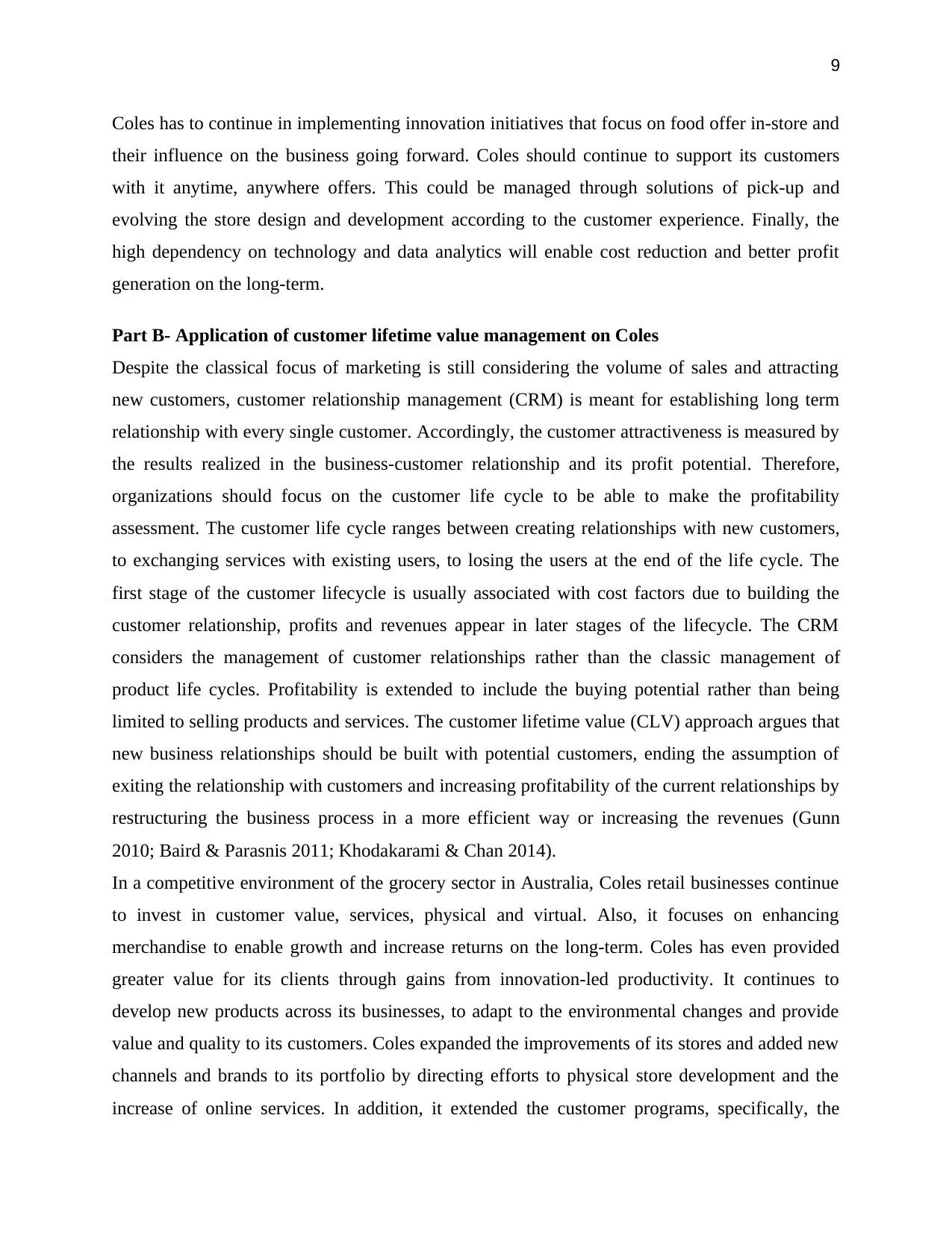
9
Coles has to continue in implementing innovation initiatives that focus on food offer in-store and
their influence on the business going forward. Coles should continue to support its customers
with it anytime, anywhere offers. This could be managed through solutions of pick-up and
evolving the store design and development according to the customer experience. Finally, the
high dependency on technology and data analytics will enable cost reduction and better profit
generation on the long-term.
Part B- Application of customer lifetime value management on Coles
Despite the classical focus of marketing is still considering the volume of sales and attracting
new customers, customer relationship management (CRM) is meant for establishing long term
relationship with every single customer. Accordingly, the customer attractiveness is measured by
the results realized in the business-customer relationship and its profit potential. Therefore,
organizations should focus on the customer life cycle to be able to make the profitability
assessment. The customer life cycle ranges between creating relationships with new customers,
to exchanging services with existing users, to losing the users at the end of the life cycle. The
first stage of the customer lifecycle is usually associated with cost factors due to building the
customer relationship, profits and revenues appear in later stages of the lifecycle. The CRM
considers the management of customer relationships rather than the classic management of
product life cycles. Profitability is extended to include the buying potential rather than being
limited to selling products and services. The customer lifetime value (CLV) approach argues that
new business relationships should be built with potential customers, ending the assumption of
exiting the relationship with customers and increasing profitability of the current relationships by
restructuring the business process in a more efficient way or increasing the revenues (Gunn
2010; Baird & Parasnis 2011; Khodakarami & Chan 2014).
In a competitive environment of the grocery sector in Australia, Coles retail businesses continue
to invest in customer value, services, physical and virtual. Also, it focuses on enhancing
merchandise to enable growth and increase returns on the long-term. Coles has even provided
greater value for its clients through gains from innovation-led productivity. It continues to
develop new products across its businesses, to adapt to the environmental changes and provide
value and quality to its customers. Coles expanded the improvements of its stores and added new
channels and brands to its portfolio by directing efforts to physical store development and the
increase of online services. In addition, it extended the customer programs, specifically, the
Coles has to continue in implementing innovation initiatives that focus on food offer in-store and
their influence on the business going forward. Coles should continue to support its customers
with it anytime, anywhere offers. This could be managed through solutions of pick-up and
evolving the store design and development according to the customer experience. Finally, the
high dependency on technology and data analytics will enable cost reduction and better profit
generation on the long-term.
Part B- Application of customer lifetime value management on Coles
Despite the classical focus of marketing is still considering the volume of sales and attracting
new customers, customer relationship management (CRM) is meant for establishing long term
relationship with every single customer. Accordingly, the customer attractiveness is measured by
the results realized in the business-customer relationship and its profit potential. Therefore,
organizations should focus on the customer life cycle to be able to make the profitability
assessment. The customer life cycle ranges between creating relationships with new customers,
to exchanging services with existing users, to losing the users at the end of the life cycle. The
first stage of the customer lifecycle is usually associated with cost factors due to building the
customer relationship, profits and revenues appear in later stages of the lifecycle. The CRM
considers the management of customer relationships rather than the classic management of
product life cycles. Profitability is extended to include the buying potential rather than being
limited to selling products and services. The customer lifetime value (CLV) approach argues that
new business relationships should be built with potential customers, ending the assumption of
exiting the relationship with customers and increasing profitability of the current relationships by
restructuring the business process in a more efficient way or increasing the revenues (Gunn
2010; Baird & Parasnis 2011; Khodakarami & Chan 2014).
In a competitive environment of the grocery sector in Australia, Coles retail businesses continue
to invest in customer value, services, physical and virtual. Also, it focuses on enhancing
merchandise to enable growth and increase returns on the long-term. Coles has even provided
greater value for its clients through gains from innovation-led productivity. It continues to
develop new products across its businesses, to adapt to the environmental changes and provide
value and quality to its customers. Coles expanded the improvements of its stores and added new
channels and brands to its portfolio by directing efforts to physical store development and the
increase of online services. In addition, it extended the customer programs, specifically, the
Secure Best Marks with AI Grader
Need help grading? Try our AI Grader for instant feedback on your assignments.
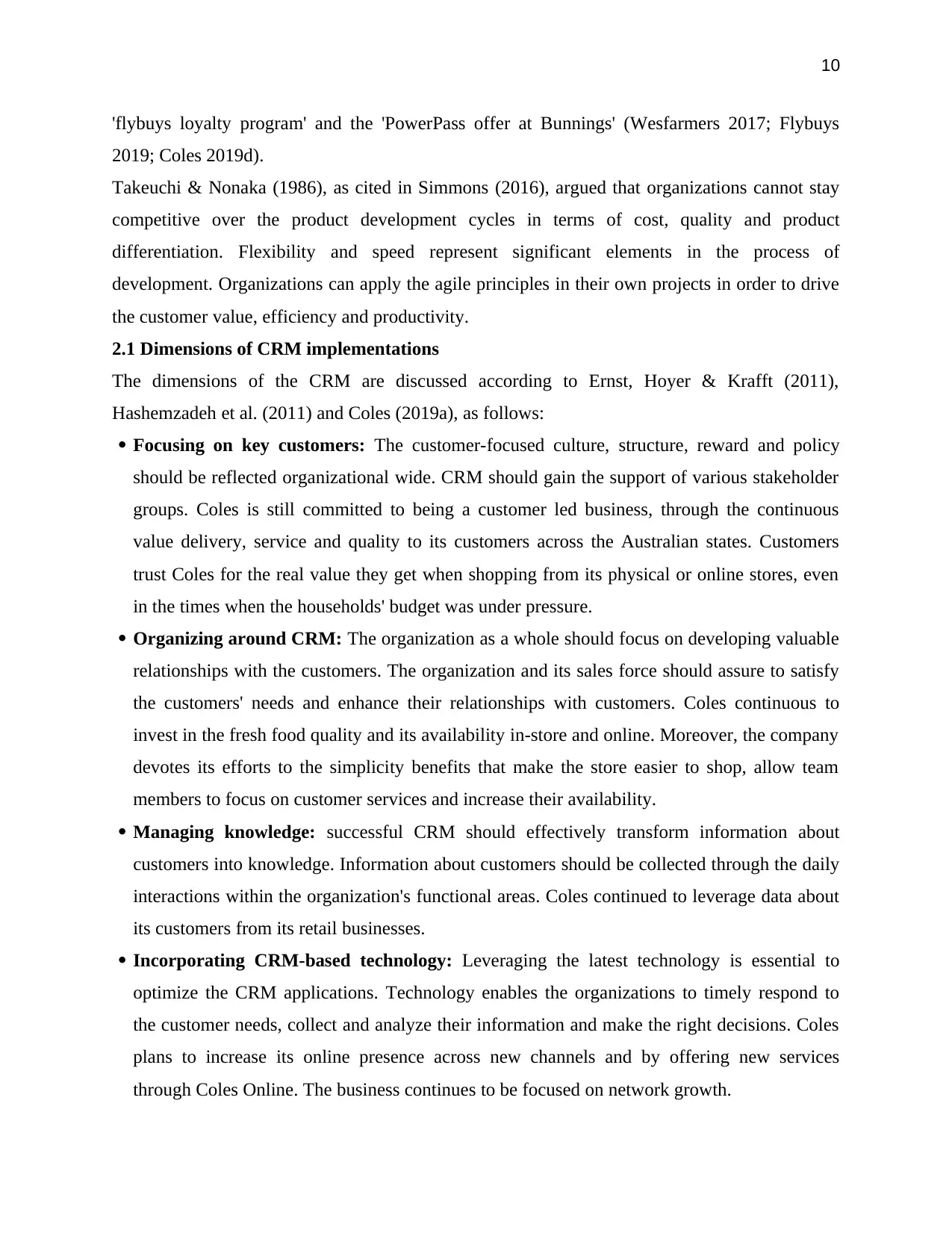
10
'flybuys loyalty program' and the 'PowerPass offer at Bunnings' (Wesfarmers 2017; Flybuys
2019; Coles 2019d).
Takeuchi & Nonaka (1986), as cited in Simmons (2016), argued that organizations cannot stay
competitive over the product development cycles in terms of cost, quality and product
differentiation. Flexibility and speed represent significant elements in the process of
development. Organizations can apply the agile principles in their own projects in order to drive
the customer value, efficiency and productivity.
2.1 Dimensions of CRM implementations
The dimensions of the CRM are discussed according to Ernst, Hoyer & Krafft (2011),
Hashemzadeh et al. (2011) and Coles (2019a), as follows:
Focusing on key customers: The customer-focused culture, structure, reward and policy
should be reflected organizational wide. CRM should gain the support of various stakeholder
groups. Coles is still committed to being a customer led business, through the continuous
value delivery, service and quality to its customers across the Australian states. Customers
trust Coles for the real value they get when shopping from its physical or online stores, even
in the times when the households' budget was under pressure.
Organizing around CRM: The organization as a whole should focus on developing valuable
relationships with the customers. The organization and its sales force should assure to satisfy
the customers' needs and enhance their relationships with customers. Coles continuous to
invest in the fresh food quality and its availability in-store and online. Moreover, the company
devotes its efforts to the simplicity benefits that make the store easier to shop, allow team
members to focus on customer services and increase their availability.
Managing knowledge: successful CRM should effectively transform information about
customers into knowledge. Information about customers should be collected through the daily
interactions within the organization's functional areas. Coles continued to leverage data about
its customers from its retail businesses.
Incorporating CRM-based technology: Leveraging the latest technology is essential to
optimize the CRM applications. Technology enables the organizations to timely respond to
the customer needs, collect and analyze their information and make the right decisions. Coles
plans to increase its online presence across new channels and by offering new services
through Coles Online. The business continues to be focused on network growth.
'flybuys loyalty program' and the 'PowerPass offer at Bunnings' (Wesfarmers 2017; Flybuys
2019; Coles 2019d).
Takeuchi & Nonaka (1986), as cited in Simmons (2016), argued that organizations cannot stay
competitive over the product development cycles in terms of cost, quality and product
differentiation. Flexibility and speed represent significant elements in the process of
development. Organizations can apply the agile principles in their own projects in order to drive
the customer value, efficiency and productivity.
2.1 Dimensions of CRM implementations
The dimensions of the CRM are discussed according to Ernst, Hoyer & Krafft (2011),
Hashemzadeh et al. (2011) and Coles (2019a), as follows:
Focusing on key customers: The customer-focused culture, structure, reward and policy
should be reflected organizational wide. CRM should gain the support of various stakeholder
groups. Coles is still committed to being a customer led business, through the continuous
value delivery, service and quality to its customers across the Australian states. Customers
trust Coles for the real value they get when shopping from its physical or online stores, even
in the times when the households' budget was under pressure.
Organizing around CRM: The organization as a whole should focus on developing valuable
relationships with the customers. The organization and its sales force should assure to satisfy
the customers' needs and enhance their relationships with customers. Coles continuous to
invest in the fresh food quality and its availability in-store and online. Moreover, the company
devotes its efforts to the simplicity benefits that make the store easier to shop, allow team
members to focus on customer services and increase their availability.
Managing knowledge: successful CRM should effectively transform information about
customers into knowledge. Information about customers should be collected through the daily
interactions within the organization's functional areas. Coles continued to leverage data about
its customers from its retail businesses.
Incorporating CRM-based technology: Leveraging the latest technology is essential to
optimize the CRM applications. Technology enables the organizations to timely respond to
the customer needs, collect and analyze their information and make the right decisions. Coles
plans to increase its online presence across new channels and by offering new services
through Coles Online. The business continues to be focused on network growth.

11
Coles has to ensure managing the delivery cost of the online shopping, to respond timely to the
products ordered by online customers, delivery of fresh food concerns of quality and time,
making special offers and promotions regularly, spend on the technology of mobile applications
and make the website user-friendly. Customer segmentation reflects the variations among
consumer preferences. This matter represents the execution of the retail model. Coles in
partnership with Wesfarmers maintains its capabilities in online selling through data mining that
supports the customer segmentation activities. Despite this, the price remains the most critical
factor in making the buying decision from the customer viewpoint. For example, consumers
prefer Coles for its fresh products, but price promotion still dominating the demand. Some
supermarket chains believe the 'everyday low pricing' is the best strategy to attract the customers
to enter the store and make them trust that they will really get low prices. Coles brand price is
34% cheaper than Woolworths brand that represents its major competitor (Han 2015).
Others believe that the 'high/low' strategy that involves products in and out of the price
promotion periods is better because it takes the benefit of impulse buys and is more likely to
attract the customers, especially the new customers. Coles new strategy after demerging from
Wesfarmers prefers to adopt the 'everyday low pricing' strategy (Canstarblue 2019).
Conclusions
Coles strategy of 2018, is ‘Fresh Tomorrow’, it represents a response to the transforming retail
environment and changing customer preferences. The company vision of the next five years is
built on its customer-led strategy. Coles CEO highlighted 6 major strategies after demerge;
transforming food offers, reviewing the method of pricing, improving the online offer,
continuous investments in the stores, cost reduction and working with the stakeholders.
Coles aims to work smarter, be more collaborative and communicate effectively with the
suppliers. It aims to remove complexities, achieve customer delight and increase its profits and
market share.
Coles supports the producers and farmers with new extended for long term contracts. Moreover,
it is committed to providing its customers with quality products considering environmental
sustainability issues.
Coles has to ensure managing the delivery cost of the online shopping, to respond timely to the
products ordered by online customers, delivery of fresh food concerns of quality and time,
making special offers and promotions regularly, spend on the technology of mobile applications
and make the website user-friendly. Customer segmentation reflects the variations among
consumer preferences. This matter represents the execution of the retail model. Coles in
partnership with Wesfarmers maintains its capabilities in online selling through data mining that
supports the customer segmentation activities. Despite this, the price remains the most critical
factor in making the buying decision from the customer viewpoint. For example, consumers
prefer Coles for its fresh products, but price promotion still dominating the demand. Some
supermarket chains believe the 'everyday low pricing' is the best strategy to attract the customers
to enter the store and make them trust that they will really get low prices. Coles brand price is
34% cheaper than Woolworths brand that represents its major competitor (Han 2015).
Others believe that the 'high/low' strategy that involves products in and out of the price
promotion periods is better because it takes the benefit of impulse buys and is more likely to
attract the customers, especially the new customers. Coles new strategy after demerging from
Wesfarmers prefers to adopt the 'everyday low pricing' strategy (Canstarblue 2019).
Conclusions
Coles strategy of 2018, is ‘Fresh Tomorrow’, it represents a response to the transforming retail
environment and changing customer preferences. The company vision of the next five years is
built on its customer-led strategy. Coles CEO highlighted 6 major strategies after demerge;
transforming food offers, reviewing the method of pricing, improving the online offer,
continuous investments in the stores, cost reduction and working with the stakeholders.
Coles aims to work smarter, be more collaborative and communicate effectively with the
suppliers. It aims to remove complexities, achieve customer delight and increase its profits and
market share.
Coles supports the producers and farmers with new extended for long term contracts. Moreover,
it is committed to providing its customers with quality products considering environmental
sustainability issues.

12
Coles private labels represent the unbranded products that supermarkets purchase and then sell as
their own products. They are cheaper products compared to other branded products due to their
limited marketing activities. Coles brand products are equally treated as branded products. They
are located side by side with similar brands with less shelf space.
Coles is still committed to being a customer led business, through the continuous value delivery,
service and quality to its customers across the Australian states. Customers trust Coles for the
real value they get when shopping from its physical or online stores, even in the times when the
households' budget was under pressure. Moreover, the company devotes its efforts to the
simplicity benefits that make the store easier to shop, allow team members to focus on customer
services and increase their availability.
Coles has to ensure managing the delivery cost of the online shopping, to respond timely to the
products ordered by online customers, delivery of fresh food concerns of quality and time,
making special offers and promotions regularly, spend on the technology of mobile applications
and make the website user-friendly. Customer segmentation reflects the variations among
consumer preferences.
Coles private labels represent the unbranded products that supermarkets purchase and then sell as
their own products. They are cheaper products compared to other branded products due to their
limited marketing activities. Coles brand products are equally treated as branded products. They
are located side by side with similar brands with less shelf space.
Coles is still committed to being a customer led business, through the continuous value delivery,
service and quality to its customers across the Australian states. Customers trust Coles for the
real value they get when shopping from its physical or online stores, even in the times when the
households' budget was under pressure. Moreover, the company devotes its efforts to the
simplicity benefits that make the store easier to shop, allow team members to focus on customer
services and increase their availability.
Coles has to ensure managing the delivery cost of the online shopping, to respond timely to the
products ordered by online customers, delivery of fresh food concerns of quality and time,
making special offers and promotions regularly, spend on the technology of mobile applications
and make the website user-friendly. Customer segmentation reflects the variations among
consumer preferences.
Paraphrase This Document
Need a fresh take? Get an instant paraphrase of this document with our AI Paraphraser
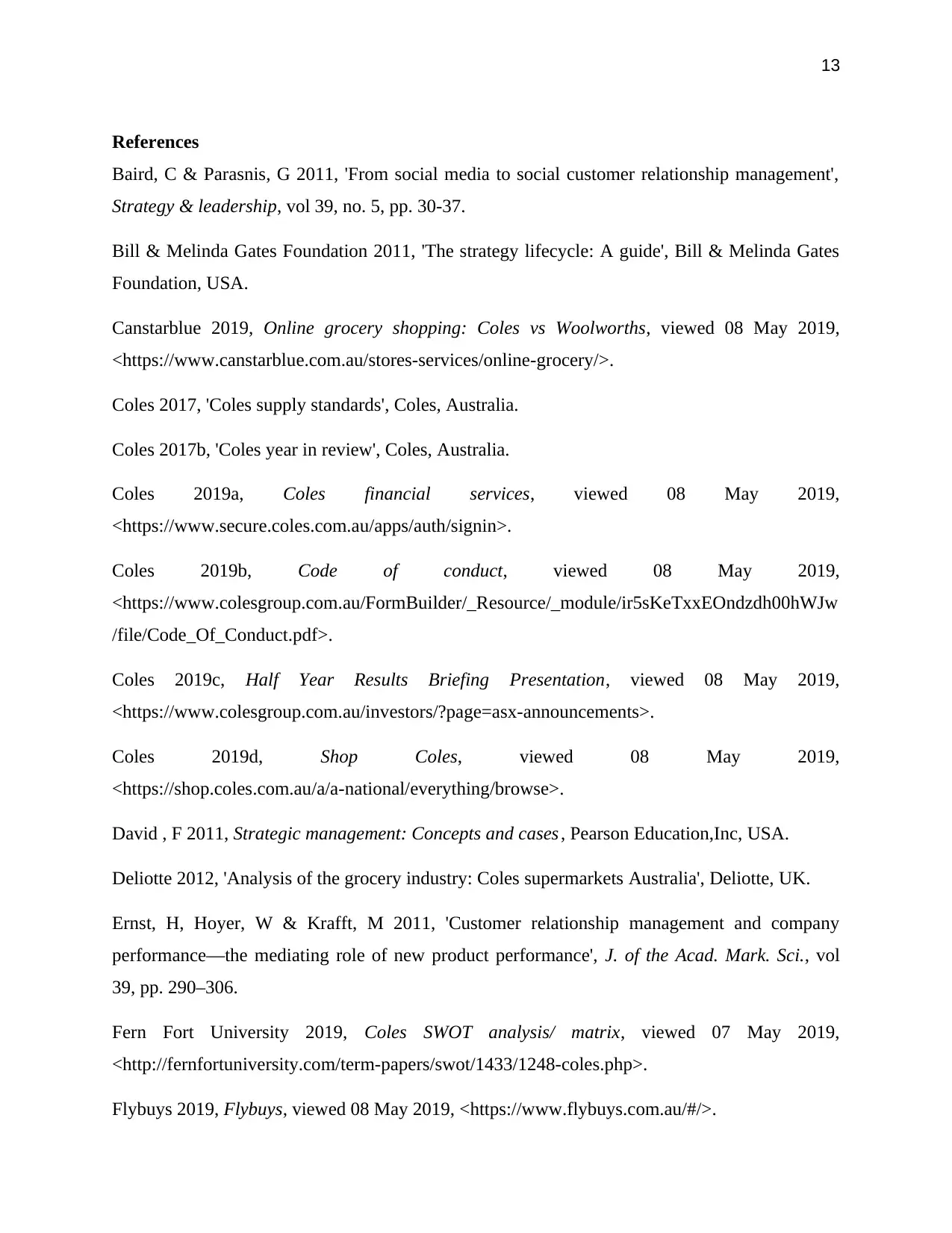
13
References
Baird, C & Parasnis, G 2011, 'From social media to social customer relationship management',
Strategy & leadership, vol 39, no. 5, pp. 30-37.
Bill & Melinda Gates Foundation 2011, 'The strategy lifecycle: A guide', Bill & Melinda Gates
Foundation, USA.
Canstarblue 2019, Online grocery shopping: Coles vs Woolworths, viewed 08 May 2019,
<https://www.canstarblue.com.au/stores-services/online-grocery/>.
Coles 2017, 'Coles supply standards', Coles, Australia.
Coles 2017b, 'Coles year in review', Coles, Australia.
Coles 2019a, Coles financial services, viewed 08 May 2019,
<https://www.secure.coles.com.au/apps/auth/signin>.
Coles 2019b, Code of conduct, viewed 08 May 2019,
<https://www.colesgroup.com.au/FormBuilder/_Resource/_module/ir5sKeTxxEOndzdh00hWJw
/file/Code_Of_Conduct.pdf>.
Coles 2019c, Half Year Results Briefing Presentation, viewed 08 May 2019,
<https://www.colesgroup.com.au/investors/?page=asx-announcements>.
Coles 2019d, Shop Coles, viewed 08 May 2019,
<https://shop.coles.com.au/a/a-national/everything/browse>.
David , F 2011, Strategic management: Concepts and cases , Pearson Education,Inc, USA.
Deliotte 2012, 'Analysis of the grocery industry: Coles supermarkets Australia', Deliotte, UK.
Ernst, H, Hoyer, W & Krafft, M 2011, 'Customer relationship management and company
performance—the mediating role of new product performance', J. of the Acad. Mark. Sci., vol
39, pp. 290–306.
Fern Fort University 2019, Coles SWOT analysis/ matrix, viewed 07 May 2019,
<http://fernfortuniversity.com/term-papers/swot/1433/1248-coles.php>.
Flybuys 2019, Flybuys, viewed 08 May 2019, <https://www.flybuys.com.au/#/>.
References
Baird, C & Parasnis, G 2011, 'From social media to social customer relationship management',
Strategy & leadership, vol 39, no. 5, pp. 30-37.
Bill & Melinda Gates Foundation 2011, 'The strategy lifecycle: A guide', Bill & Melinda Gates
Foundation, USA.
Canstarblue 2019, Online grocery shopping: Coles vs Woolworths, viewed 08 May 2019,
<https://www.canstarblue.com.au/stores-services/online-grocery/>.
Coles 2017, 'Coles supply standards', Coles, Australia.
Coles 2017b, 'Coles year in review', Coles, Australia.
Coles 2019a, Coles financial services, viewed 08 May 2019,
<https://www.secure.coles.com.au/apps/auth/signin>.
Coles 2019b, Code of conduct, viewed 08 May 2019,
<https://www.colesgroup.com.au/FormBuilder/_Resource/_module/ir5sKeTxxEOndzdh00hWJw
/file/Code_Of_Conduct.pdf>.
Coles 2019c, Half Year Results Briefing Presentation, viewed 08 May 2019,
<https://www.colesgroup.com.au/investors/?page=asx-announcements>.
Coles 2019d, Shop Coles, viewed 08 May 2019,
<https://shop.coles.com.au/a/a-national/everything/browse>.
David , F 2011, Strategic management: Concepts and cases , Pearson Education,Inc, USA.
Deliotte 2012, 'Analysis of the grocery industry: Coles supermarkets Australia', Deliotte, UK.
Ernst, H, Hoyer, W & Krafft, M 2011, 'Customer relationship management and company
performance—the mediating role of new product performance', J. of the Acad. Mark. Sci., vol
39, pp. 290–306.
Fern Fort University 2019, Coles SWOT analysis/ matrix, viewed 07 May 2019,
<http://fernfortuniversity.com/term-papers/swot/1433/1248-coles.php>.
Flybuys 2019, Flybuys, viewed 08 May 2019, <https://www.flybuys.com.au/#/>.
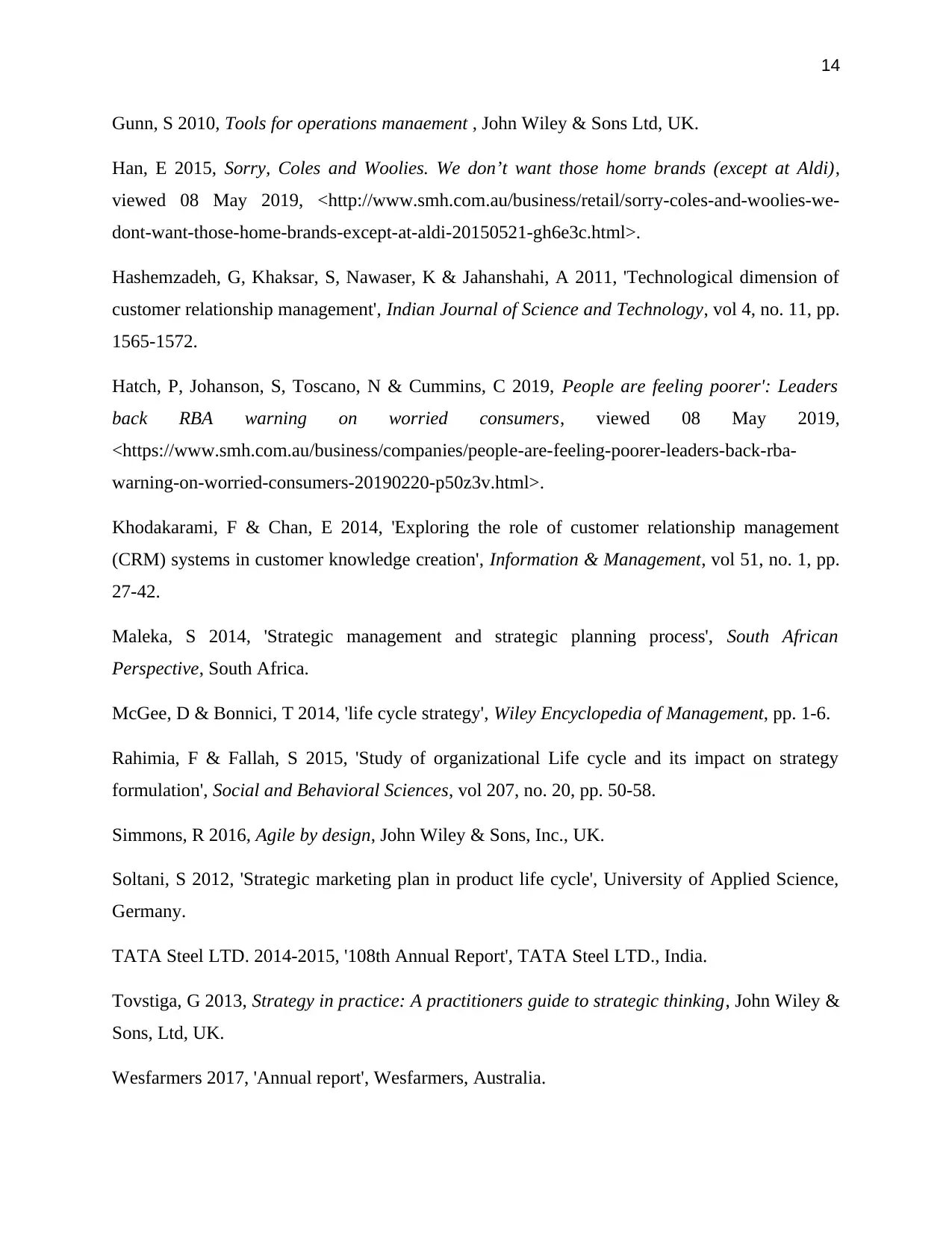
14
Gunn, S 2010, Tools for operations manaement , John Wiley & Sons Ltd, UK.
Han, E 2015, Sorry, Coles and Woolies. We don’t want those home brands (except at Aldi),
viewed 08 May 2019, <http://www.smh.com.au/business/retail/sorry-coles-and-woolies-we-
dont-want-those-home-brands-except-at-aldi-20150521-gh6e3c.html>.
Hashemzadeh, G, Khaksar, S, Nawaser, K & Jahanshahi, A 2011, 'Technological dimension of
customer relationship management', Indian Journal of Science and Technology, vol 4, no. 11, pp.
1565-1572.
Hatch, P, Johanson, S, Toscano, N & Cummins, C 2019, People are feeling poorer': Leaders
back RBA warning on worried consumers, viewed 08 May 2019,
<https://www.smh.com.au/business/companies/people-are-feeling-poorer-leaders-back-rba-
warning-on-worried-consumers-20190220-p50z3v.html>.
Khodakarami, F & Chan, E 2014, 'Exploring the role of customer relationship management
(CRM) systems in customer knowledge creation', Information & Management, vol 51, no. 1, pp.
27-42.
Maleka, S 2014, 'Strategic management and strategic planning process', South African
Perspective, South Africa.
McGee, D & Bonnici, T 2014, 'life cycle strategy', Wiley Encyclopedia of Management, pp. 1-6.
Rahimia, F & Fallah, S 2015, 'Study of organizational Life cycle and its impact on strategy
formulation', Social and Behavioral Sciences, vol 207, no. 20, pp. 50-58.
Simmons, R 2016, Agile by design, John Wiley & Sons, Inc., UK.
Soltani, S 2012, 'Strategic marketing plan in product life cycle', University of Applied Science,
Germany.
TATA Steel LTD. 2014-2015, '108th Annual Report', TATA Steel LTD., India.
Tovstiga, G 2013, Strategy in practice: A practitioners guide to strategic thinking, John Wiley &
Sons, Ltd, UK.
Wesfarmers 2017, 'Annual report', Wesfarmers, Australia.
Gunn, S 2010, Tools for operations manaement , John Wiley & Sons Ltd, UK.
Han, E 2015, Sorry, Coles and Woolies. We don’t want those home brands (except at Aldi),
viewed 08 May 2019, <http://www.smh.com.au/business/retail/sorry-coles-and-woolies-we-
dont-want-those-home-brands-except-at-aldi-20150521-gh6e3c.html>.
Hashemzadeh, G, Khaksar, S, Nawaser, K & Jahanshahi, A 2011, 'Technological dimension of
customer relationship management', Indian Journal of Science and Technology, vol 4, no. 11, pp.
1565-1572.
Hatch, P, Johanson, S, Toscano, N & Cummins, C 2019, People are feeling poorer': Leaders
back RBA warning on worried consumers, viewed 08 May 2019,
<https://www.smh.com.au/business/companies/people-are-feeling-poorer-leaders-back-rba-
warning-on-worried-consumers-20190220-p50z3v.html>.
Khodakarami, F & Chan, E 2014, 'Exploring the role of customer relationship management
(CRM) systems in customer knowledge creation', Information & Management, vol 51, no. 1, pp.
27-42.
Maleka, S 2014, 'Strategic management and strategic planning process', South African
Perspective, South Africa.
McGee, D & Bonnici, T 2014, 'life cycle strategy', Wiley Encyclopedia of Management, pp. 1-6.
Rahimia, F & Fallah, S 2015, 'Study of organizational Life cycle and its impact on strategy
formulation', Social and Behavioral Sciences, vol 207, no. 20, pp. 50-58.
Simmons, R 2016, Agile by design, John Wiley & Sons, Inc., UK.
Soltani, S 2012, 'Strategic marketing plan in product life cycle', University of Applied Science,
Germany.
TATA Steel LTD. 2014-2015, '108th Annual Report', TATA Steel LTD., India.
Tovstiga, G 2013, Strategy in practice: A practitioners guide to strategic thinking, John Wiley &
Sons, Ltd, UK.
Wesfarmers 2017, 'Annual report', Wesfarmers, Australia.
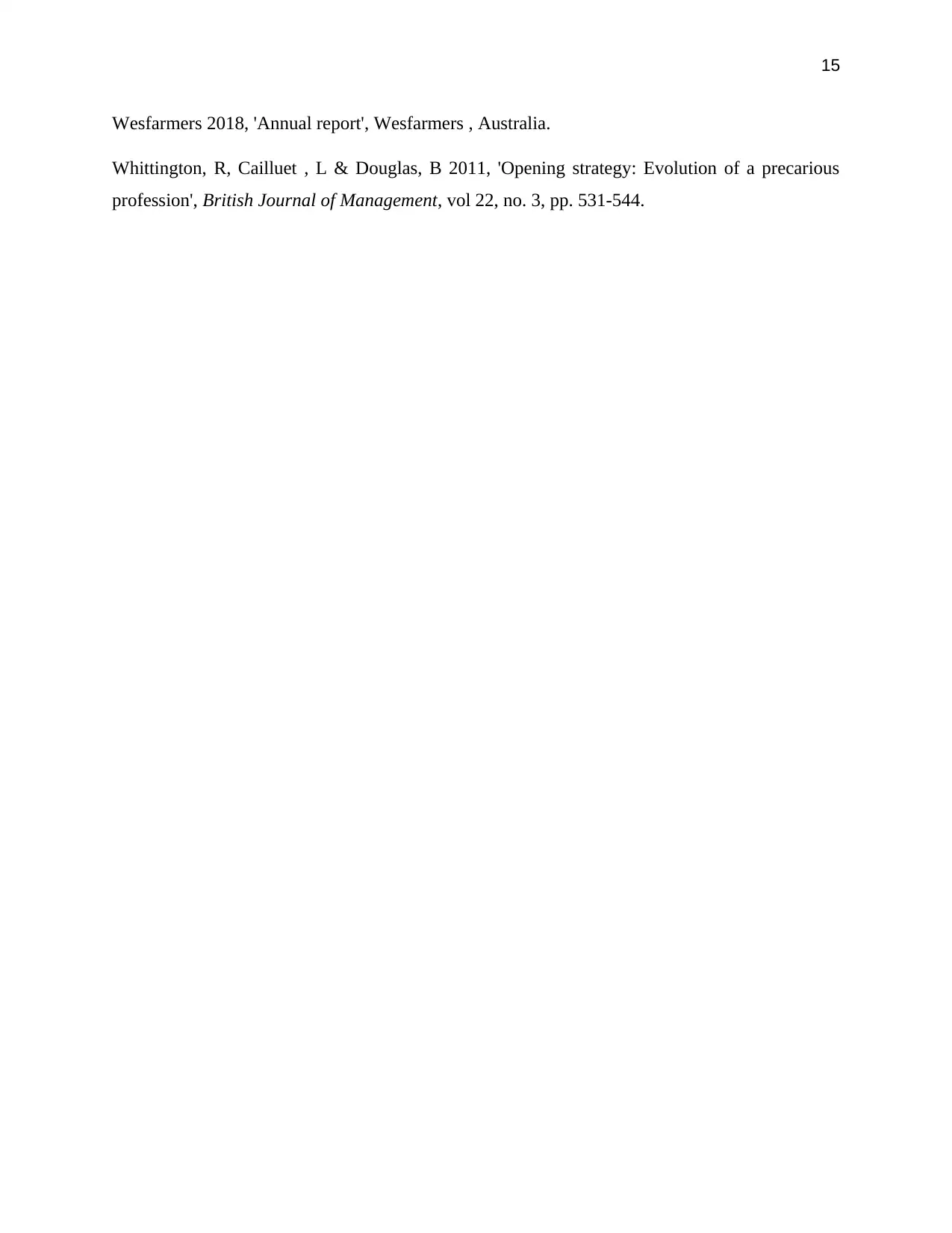
15
Wesfarmers 2018, 'Annual report', Wesfarmers , Australia.
Whittington, R, Cailluet , L & Douglas, B 2011, 'Opening strategy: Evolution of a precarious
profession', British Journal of Management, vol 22, no. 3, pp. 531-544.
Wesfarmers 2018, 'Annual report', Wesfarmers , Australia.
Whittington, R, Cailluet , L & Douglas, B 2011, 'Opening strategy: Evolution of a precarious
profession', British Journal of Management, vol 22, no. 3, pp. 531-544.
1 out of 16
Related Documents
Your All-in-One AI-Powered Toolkit for Academic Success.
+13062052269
info@desklib.com
Available 24*7 on WhatsApp / Email
![[object Object]](/_next/static/media/star-bottom.7253800d.svg)
Unlock your academic potential
© 2024 | Zucol Services PVT LTD | All rights reserved.



